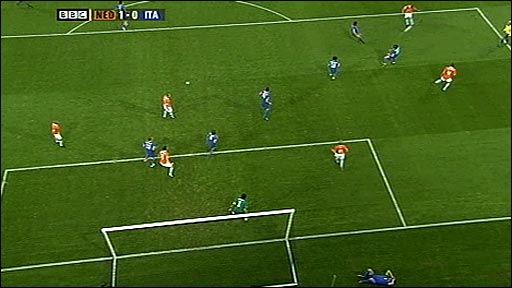
By Otto Spijkers
The first goal in the match between the Netherlands and Italy has triggered a lot of debate on the ‘legality’ of the goal. Was it according to the rules? The referee, who has the ultimate authority to apply the rules, decided to count the goal. But was that a correct decision? On the website of the BBC, the case is hotly debated, with over a 1000 comments attracted thus far. This is a summary of the facts of the case:
A Dutch player (Ruud van Nistelrooy) stands in front of the goal. He receives the ball from a fellow Dutchman who is further away from the goal line than van Nistelrooy at the time of passing, and van Nistelrooy then kicks the ball in the net. At that moment, there is no Italian defender between him and the keeper (see picture). Just behind the goal you can see an Italian defender, Christian Panucci, who seems injured at the time the goal is scored.
The applicable law is Rule 11 of the Laws of the Game 2007/2008. It states, as far as relevant:
Offside Position
A player is in an offside position if:
– he is nearer to his opponents’ goal line than both the ball and the second last opponent
A player is not in an offside position if:
– he is in his own half of the field of play or
– he is level with the second last opponent or
– he is level with the last two opponents.
When we wish to apply the law to the situation, we need first to look at the law itself and interpret it by using the textual method of interpretation, and, if that doesn’t solve the problem, we look at relevant case law, i.e. similar situations in the past, and authoritative interpretations of those situations. The big chief, UEFA General Secretary David Taylor, did exactly that, and this are his findings:
The starting point, said Mr Taylor, is the Laws of the Game – Law 11 – which deal with offside, whereby a player is in an offside position if he is nearer to his opponents’ goalline than both the ball and the second-last opponent. "There need to be two defenders involved," the UEFA General Secretary said. "If you think back to the situation, the first is the goalkeeper, and the second is the defender who, because of his momentum, actually had left the field of play. But this defender was still deemed to be part of the game. Therefore he is taken into consideration as one of the last two opponents. As a result, Ruud van Nistelrooy was not nearer to the opponents’ goal than the second-last defender and, therefore, could not be in an offside position. Rare incident "This is a widely-known interpretation of the offside law among referees that is not generally known by the wider football public," he continued. "Incidents like this are very unusual – although I’m informed that there was an incident like this about a month ago in a Swiss Super League match between FC Sion and FC Basel 1893. [It was] initially suggested that this [goal] was a mistake by the referee in terms of the offside law – the commentator later apologised publicly, as he didn’t realise that this was the correct application of the law." Law applied Mr Taylor concluded: "So let’s be clear – the referees’ team applied the law in the correct manner. If we did not have this interpretation of the player being off the pitch then what could happen is that the defending team could use the tactic of stepping off the pitch deliberately to play players offside, and that clearly is unacceptable. The most simple and practical interpretation of the law in this instance is the one that is adopted by referees throughout the world – that is that unless you have permission from the referee to be off the pitch, you are deemed to be on it and deemed to be part of the game. That is why the Italian defender, even though his momentum had taken him off the pitch, was still deemed to be part of the game, and therefore the attacking player put the ball into the net, and it was a valid goal. The law in this place was applied absolutely correctly."
The case law referred to above is from the Swiss Super League, and thus not an international situation. But I guess in soccer you can also use domestic case law in order to clarify an international dispute. The Italians in fact seem to admit this is so, because they came up with the case of Fiorentina – AS Roma, as recent as March 2006. Roma scored a goal, while a Fiorentina defender was behind his own goal. The goal was approved, but the difference, according to the Italian press, was that the Fiorentina defender was about to get back into the game, while in the Netherlands-Italy case the defender was injured. In law, this is a common argument against any precedent: just explain why the circumstances were different. But the difference has to be ‘legally relevant’. The argument clearly did not convince Mr. Taylor, who still deemed the Italian defender to be part of the game, despite the fact that he left the field of play because of an alleged injury.

There are known to be two good Dutch teams at Euro 2008, Holland and Holland reserves, and now there is a third. Russia […] Having taught Russia all they know, Holland may now fear this knowledge is about to be used against them. Either way, the future is orange, although perhaps with a hint of red.
http://www.timesonline.co.uk/tol/sport/football/international/euro_2008/article4168206.ece